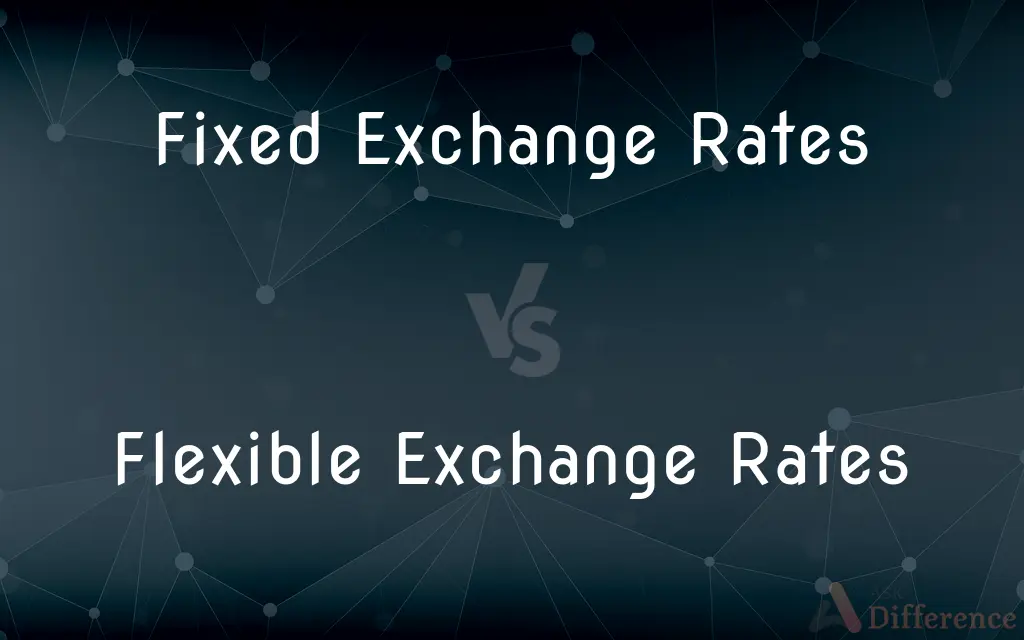Fixed Exchange Rates vs. Flexible Exchange Rates — What's the Difference?
Edited by Tayyaba Rehman — By Fiza Rafique — Published on December 14, 2023
Fixed Exchange Rates are set by a country's government or central authority, while Flexible Exchange Rates fluctuate based on market forces.

Difference Between Fixed Exchange Rates and Flexible Exchange Rates
Table of Contents
ADVERTISEMENT
Key Differences
Fixed Exchange Rates represent a currency's value that's determined and maintained by the government or a central authority. In this system, the currency's value is pegged to another major currency or a basket of currencies. Flexible Exchange Rates, on the other hand, are determined by the foreign exchange market, reflecting demand and supply dynamics.
With Fixed Exchange Rates, the government or central bank intervenes in the foreign exchange market to keep the currency's value consistent. This might involve buying or selling its own currency. Conversely, in the realm of Flexible Exchange Rates, the currency value can change frequently, driven by market factors like trade balances, interest rates, and economic indicators.
Fixed Exchange Rates can provide stability and predictability for international trade, minimizing risks linked to currency fluctuations. However, it can be challenging to maintain, especially if market pressures strongly push against the pegged rate. Flexible Exchange Rates can adapt to economic changes more swiftly, but they're susceptible to short-term volatility, potentially affecting trade and investments.
When a country adopts Fixed Exchange Rates, it forgoes some monetary policy independence, as it often has to align its interest rates and inflation to the country it's pegged to. Flexible Exchange Rates, however, allow countries to have more independent monetary policies, adjusting according to their own economic situations.
Comparison Chart
Determination
Set by the government or central authority.
Determined by market forces.
ADVERTISEMENT
Fluctuation
Rare, unless officially revalued or devalued.
Can change frequently based on demand and supply.
Government Intervention
Active intervention to maintain the rate.
Little to no intervention in most cases.
Economic Adaptability
Slower, as changes require official decisions.
Faster, as rates automatically adjust to economic factors.
Policy Independence
Limited monetary policy independence.
More monetary policy independence.
Compare with Definitions
Fixed Exchange Rates
Currency value determined by a central authority.
The country maintained Fixed Exchange Rates to stabilize trade with its major partners.
Flexible Exchange Rates
A floating currency system.
Investors had to monitor the news closely in countries with Flexible Exchange Rates.
Fixed Exchange Rates
Stable currency values maintained by government interventions.
Due to Fixed Exchange Rates, the central bank often bought its own currency to maintain the peg.
Flexible Exchange Rates
Rates shaped by demand and supply dynamics.
Improved trade balances often strengthened currencies in nations with Flexible Exchange Rates.
Fixed Exchange Rates
Rates that resist market-driven fluctuations.
Tourists preferred countries with Fixed Exchange Rates for predictable conversion rates.
Flexible Exchange Rates
A system responsive to economic indicators.
With Flexible Exchange Rates, the currency reacted swiftly to changes in global oil prices.
Fixed Exchange Rates
A system requiring reserves to maintain currency value.
The nation's reserves supported its commitment to Fixed Exchange Rates.
Flexible Exchange Rates
Currency value determined by market forces.
The country's move to Flexible Exchange Rates meant more day-to-day currency volatility.
Fixed Exchange Rates
A pegged currency system.
With Fixed Exchange Rates, sudden currency shocks were less of a concern for exporters.
Flexible Exchange Rates
No fixed peg or predetermined rate.
Following geopolitical events, countries with Flexible Exchange Rates experienced sharp currency adjustments.
Common Curiosities
How are Fixed Exchange Rates determined?
Fixed Exchange Rates are determined and maintained by a country's government or central authority.
Can a country switch between these systems?
Yes, countries can transition between Fixed and Flexible Exchange Rates based on their economic policies.
Which system provides more currency stability?
Fixed Exchange Rates typically offer more currency stability.
How do Flexible Exchange Rates fluctuate?
Flexible Exchange Rates fluctuate based on market forces like demand and supply.
Are Flexible Exchange Rates more adaptable to economic changes?
Yes, Flexible Exchange Rates can adjust swiftly to economic dynamics.
How do interest rates impact Flexible Exchange Rates?
Higher interest rates can attract foreign capital, potentially appreciating the currency in a Flexible Exchange Rate system.
How do trade balances influence Flexible Exchange Rates?
Trade surpluses can increase demand for a country's currency, potentially appreciating it in a Flexible Exchange Rate system.
Can a peg in Fixed Exchange Rates be changed?
Yes, governments can decide to revalue or devalue their currency peg.
Why might a country prefer Fixed Exchange Rates?
To provide currency stability, protect against speculation, and enhance international trade predictability.
What are the drawbacks of Fixed Exchange Rates?
It can strain a country's reserves, reduce monetary policy independence, and may not always reflect true market value.
Are Flexible Exchange Rates more transparent?
Generally, yes, since they reflect real-time market sentiments.
What happens when market pressures conflict with a Fixed Exchange Rate?
The government may spend reserves to maintain the rate or may decide to adjust the peg.
Do countries with Fixed Exchange Rates need substantial foreign reserves?
Yes, to maintain the peg and intervene in the forex market if needed.
Which system is more predictable for international businesses?
Fixed Exchange Rates offer more predictability for international transactions.
Can geopolitical events influence Flexible Exchange Rates?
Absolutely, geopolitical events can lead to market uncertainties, affecting currencies in Flexible Exchange Rate systems.
Share Your Discovery

Previous Comparison
VNTR vs. STR
Next Comparison
Colony Hybridization vs. Plaque HybridizationAuthor Spotlight
Written by
Fiza RafiqueFiza Rafique is a skilled content writer at AskDifference.com, where she meticulously refines and enhances written pieces. Drawing from her vast editorial expertise, Fiza ensures clarity, accuracy, and precision in every article. Passionate about language, she continually seeks to elevate the quality of content for readers worldwide.
Edited by
Tayyaba RehmanTayyaba Rehman is a distinguished writer, currently serving as a primary contributor to askdifference.com. As a researcher in semantics and etymology, Tayyaba's passion for the complexity of languages and their distinctions has found a perfect home on the platform. Tayyaba delves into the intricacies of language, distinguishing between commonly confused words and phrases, thereby providing clarity for readers worldwide.










































